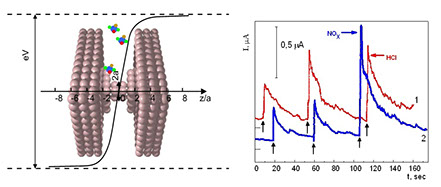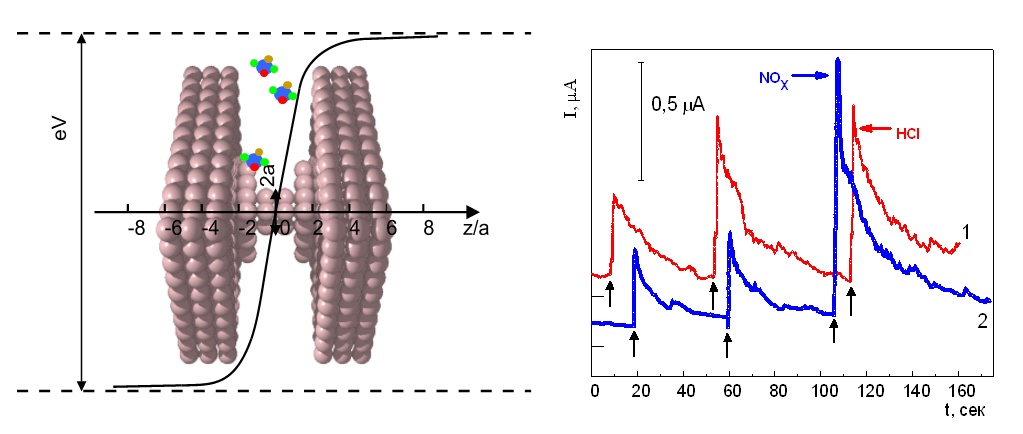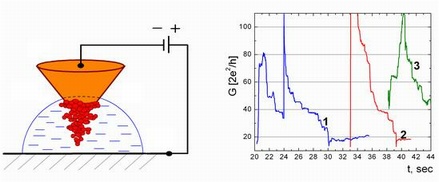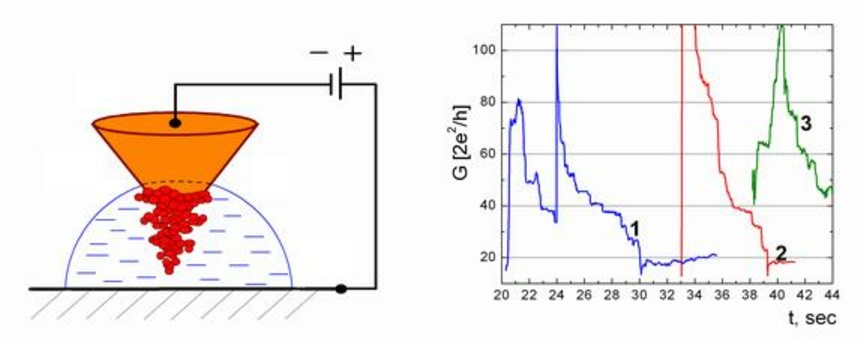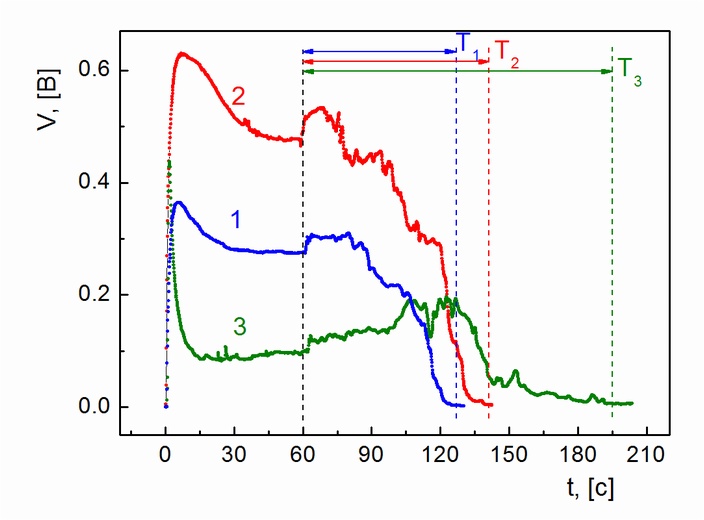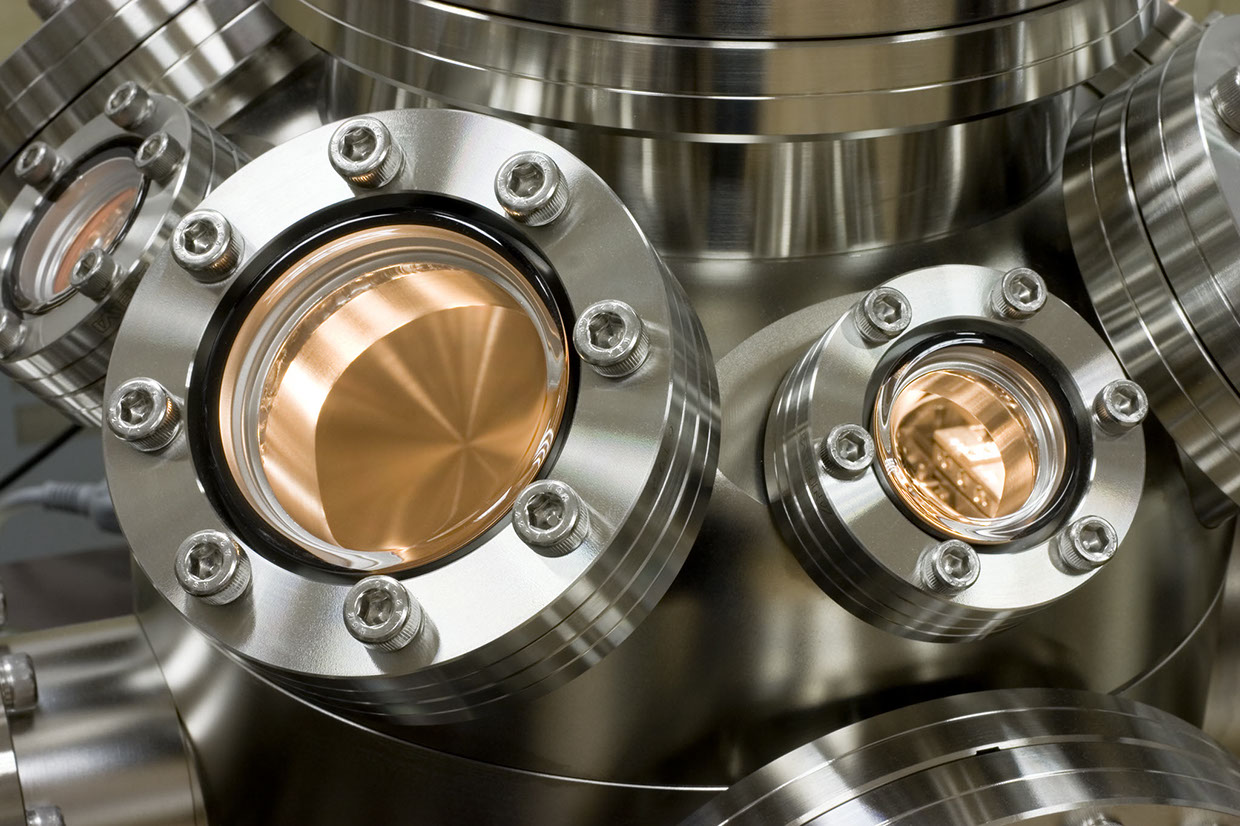
Research team for studies of sensor properties of materials
People
Prof. G.V. Kamarchuk, Head of Department, Doctor of Physico-Mathematical Sciences
Dr. V.I. Belan, Senior Researcher
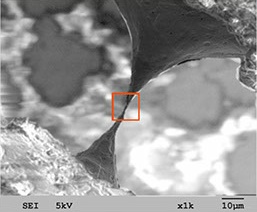
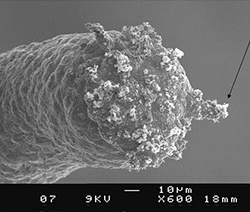
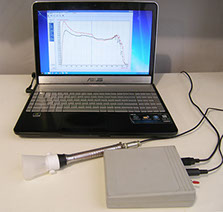
Main areas of research
● Study of sensor properties of point-contact nanostructures
● Study of spectral phenomena in nanostructured materials
● Study of nonlinear current states in low-dimensional systems
● Analysis of exhaled human breath
● Development of new methods for creating nanoscale samples and materials
● Study of electro-induced cyclic effects
● Development of new methods of noninvasive diagnosis of human body states
Main experimental techniques
Yanson point-contact spectroscopy, point-contact method for analysis of gaseous and liquid media, method of functional simulation of low-dimensional metallic structures (conception of elongated element).
Equipment
Research complex based on five-channel point-contact spectrometer.
Portable equipment for detecting complex gaseous media with point-contact sensors.
Current studies
1. Nonlinear current states of point contacts in gaseous media

This research area deals with objects and phenomena which can be studied by applying the fundamental principles and technological approaches of Yanson point-contact spectroscopy related to the gas-sensitive effect. The fact that the researchers of Department together with their co-authors have already created ultrasensitive point-contact nanosensors exploiting the point-contact gas-sensitive effect and characterized by parameters that excel those of the existing analogues makes the studies quite promising. Nonlinear current states in electrical conductivity of point-contact sensors are the key to understanding the nature of the point-contact gas-sensitive effect and thus provide multiple possibilities of development of brand new sensors and advanced sensor-based technologies.
Leading researchers: V.A. Gudimenko and D.A. Harbuz.
The pioneering observation of point contact’s electric conductivity variation under action of gas media which caused the discovery of the point-contact gas-sensitive effect. [Europhys. Lett., 76(4), 575-581, 2006].
2. Quantum sensorics for detecting gases and liquids

This new area in sensorics proposed by the researchers of Department is based on the study of energy of interaction between a point-contact structure and a gas or liquid by means of finding and analyzing the parameters of quantized electrical conductivity of the point contacts. The quantum nature of electrical properties of point contacts makes it possible to register very subtle states of the point-contact conductivity channel caused by adsorption of an external agent. The measurement can be performed with a resolution down to a quantum of conductivity, which corresponds to the addition of an atom of the investigated substance to the point contact. As a result, point-contact sensors possess an ultrahigh sensitivity up to the highest sensitivity levels of sensor devices known so far. The quantum approach opens up wide possibilities of developing a broad spectrum of new methods, devices, and technologies, since the knowledge of energetic parameters of a physical system is a key factor for being able to determine and foresee its properties. Energetic parameters of the response of point-contact sensors allow one not only to distinguish materials from one another, but also to analyze complex gaseous media via registration their profiles without determination of single components of the medium.
Leading researchers: A.V. Savytskyi and A.O. Herus.
New cyclic switchover effect which is accompanied by formation of quantum dendrite Yanson point contacts. [J. Phys. Chem. C, 119(1), pp. 632–639, 2015].
3. Structural and electrophysical properties of point-contact sensor multistructures

The importance of the study of point-contact sensor multistructures arises from their unique properties, among which is a complex spectrum-like response generated by point contacts under the action of multicomponent gaseous media. Before it was discovered by the researchers of the Team and their co-authors, this type of the response signal had been unknown for sensor devices based on the measurement of electrical conductivity. The reason is that point contacts are nanostructured objects of quantum nature, so they can register minute structural and energetic variations caused by adsorption of external agents. Temporal characteristics of the response signal generated by a point-contact sensor device provide information about the adsorption energy levels of the gas ingredients. The complex gas mixture affects the time dependence of electrical conductivity of point contacts, which results in its spectrum-like form similar to a point-contact spectrum obtained in Yanson point-contact spectroscopy. This peculiarity of point contacts allows one to analyze complex gas mixtures by taking a general profile of a gaseous medium without the need to determine its particular components. This ensures realization of a new method for analysis of a complex molecular system with point-contact sensor devices. The proposed approach has no analogues in sensor engineering. Its effectiveness has been demonstrated by the analyses of exhaled human breath performed by the researchers of Department in collaboration with their co-authors. Making use of the fact that this complex biological gaseous medium contains metabolic products of bacteria a human body is infected with, we first proved the possibility of detecting carcinogenic strains of Helicobacter pylori in real-time mode. The results of this innovative study were published in the leading scientific journal – Journal of Breath Research (December 2015) – and presented on the site of the National Academy of Sciences of Ukraine (NASU) in April 2016 as one of the most outstanding scientific achievements of the NASU researchers. The importance of the discovery made by the scientists of Department and their co-authors lies in the fact that none of the currently existing methods for determining Helicobacter pylori can be used as a screening diagnostic method because of their high cost. It should also be noted that none of the known methods is able to determine carcinogenic strains of the bacterium in real-time mode. The possibility of using point-contact sensors to analyze the exhaled breath opens up real prospects for development of a new generation of breath tests which, thanks to their simplicity and affordability, can be widely used for large-scale screening and monitoring of great masses of population. This will help to timely detect carcinogenic strains of Helicobacter pylori and prevent development of ulcer diseases and gastric cancer in an early stage of infection even in countries with low income.
Another application that point-contact multistructures based on TCNQ compounds have found is sensors for the determining human hormonal background. In our recent studies, we have shown that such sensors can be successfully used for express analysis of the content in the body of such important hormones as melaton, serotonin and cortisol by breath gas analysis.
An important feature of the point contacts implementing to determine the content of hormones in the human body is the fact that such task can be solved by two different approaches. The first approach is parametric, similar the to one we previously used to detect Helicobacter pylori strains. The other method is a unique development based on the spectral nature of the sensor response to the action of a gaseous agent. Understanding this feature made it possible to find temporal sections on the breath gas profile corresponding to the concentrations of the certain components in the biological substance under study.
The results of the research carried out are both fundamental and applied. From a fundamental point of view, the possibility of localizing an area of the curve corresponding to a certain binding energy of a substance with a surface classifies point-contact sensors as a spectroscopic research tool. The applied character is the the application area of such sensors expansion in the direction of medical diagnostics. An inexpensive, compact and easy-to-maintain tool that provides non-invasive analysis of human hormonal levels in real time is definitely promising both for express diagnosis of a human body condition and for monitoring the treatment process.
Leading researchers: V.A. Gudimenko, D.A. Harbuz, V.I. Belan, and M.D. Romanov.
Point-contact sensor breath test which makes it possible to detect toxigenic strains of Helicobacter pylori infection in the real-time mode. [J. Breath Res. 9(4), 047111 (14 pp) 2015].
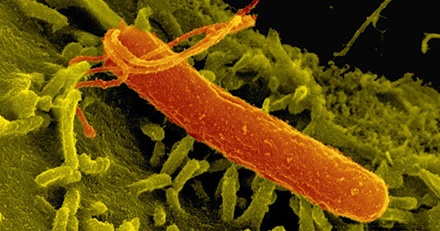
Helicobacter pylori bacterium on the mucous membrane of the stomach.
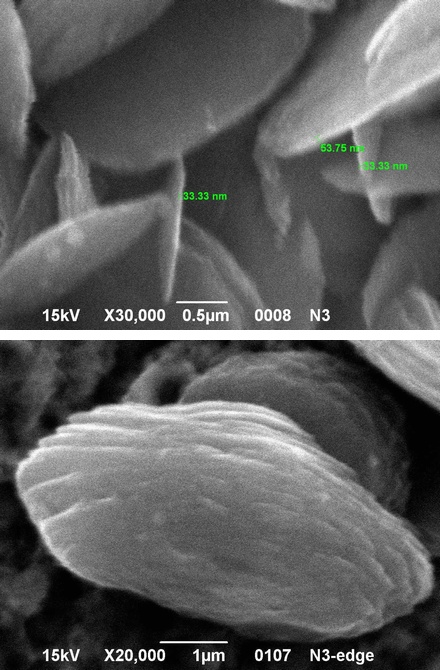
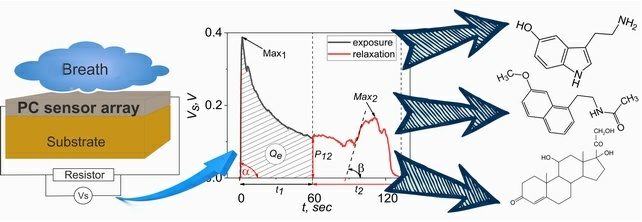
Бактерия Helicobacter pylori на слизистой оболочке желудка.
^^^ The unique morphology of the sensitive surface .
<<< Point-contact sensor capabilities to investigate the content of
the certain hormones in the human body by breath gas analysis.
Key results
Point-contact gas-sensitive effect was discovered. The essence of the phenomenon is the possibility for electrical conductivity of a point contact to be influenced by small (of ppm order or smaller) concentrations of gases with donor or acceptor properties with respect to the contact material and then quickly relax to its equilibrium value after the action of the external object ceases. A new research area is proposed in the fields of Yanson point-contact spectrocopy and solid state physics and is related to point contacts used for analysis of gaseous media. The effectiveness of the new method has been demonstrated by the creation of brand new ultrasensitive point-contact sensors with characteristics well above those of the presently existing analogues.
Gas-sensitivity effect of point heterocontacts was discovered. It was shown that heterocontacts between electrodes made of gold and single-walled carbon nanotubes change their electrical resistance under minimal action of the gaseous medium they are exposed to. After the gas stops acting, the parameters of the studied samples recover to their equilibrium values. The discovered effect is the basis for creation of brand new nanosensors with better parameters than those of the currently available analogous sensors.
Giant effect of gas sensitivity of TCNQ-based organic conductors was discovered which consisted in an increase of 2-3 orders of magnitude in their electrical conductivity under the action of exhaled human breath.
For the first time a mesoscopic point-contact multistructure on the basis of organic conductor TCNQ was developed and used to prepare samples of gas-sensitive sensors. The new sensors were found to generate a reproducible integral response to the action of exhaled human breath and provide a much larger amount of information compared to the standard chemical sensors. This allowed us to propose a brand new approach to the sensor analysis of exhaled breath and reveal some important correlations between the response curve parameters and human body states.
In the course of creation of dendrite-type point-contact nanostructures the new electrochemical cyclic switchover effect was discovered which resulted in the variation with time of point-contact structure resistance changing its behaviour from growth to fall and stabilization. This effect is due to periodic nanoscale transformations of the sample structure and thus enables a delicate control over parameters of point contacts to be created. The cyclic variations of conductivity during the electrochemical synthesis of dendrite point contacts make it possible to produce nanostructures with a preset atomic resolution.
An original method of high-precision determination of energy needed for an electrochemical reaction to occur was proposed and realized for the first time. The method is based on the new quality of nanostructured point contacts – transformation into a previously unknown type of electrochemical electrode system, the elongated nanostructured electrochemical element, upon immersion into a liquid medium. The method allows one to find the onset energies of electrochemical reactions on the atomic scale and can become a basis for development of novel sensor technologies for selective detection of components of complex molecular systems in liquid and gaseous states.
A non-urease nature of the response of point-contact sensors to the action of a gas mixture exhaled by patients infected with Helicobacter pylori was established. This infection is the main causative agent of ulcer diseases and gastric cancer. A conceptually new approach to noninvasive diagnosis of Helicobacter pylori based on the point-contact sensor analysis of exhaled breath containing its non-urease metabolic products was proposed.
An original noninvasive approach to prompt detection of carcinogenic strains of Helicobacter pylori causing a series of dangerous diseases like stomach ulcer and gastric cancer was proposed for the first time. The method is based on the point-contact sensor analysis of exhaled human breath. Simplicity and low cost of devices developed on the basis of the new method will allow them to be used for screening and monitoring of large masses of population even in countries with low income. This will help to solve one of the top-priority problems of the World Health Organization – prevention of diseases in early stages of infection with the mentioned bacterium strains.
The nature of the quantum mechanisms of selective detection in complex gas mixtures has been revealed by the employees of the Department of Spectroscopy of Molecular Systems and Nanostructured Materials [Sci. Rep. 2023]. The existence and properties of these mechanisms have been comprehensively demonstrated via the development of methods for analyzing complex systems, which have no analogues, and subsequent application of the designed innovative point-contact sensor tools, which are important for noninvasive medical diagnostics in real-time mode.
Key publications
G. Kamarchuk, A. Pospelov, L. Kamarchuk, V. Belan, A. Herus, A. Savytskyi, V. Vakula, D. Harbuz, V. Gudimenko & E. Faulques. Quantum mechanisms for selective detection in complex gas mixtures using conductive sensors. Sci Rep 13, 21432 (2023).
DOI: 10.1038/s41598-023-48207-0.
A. Savytskyi, A. Pospelov, A. Herus, V. Vakula, N. Kalashnyk, E. Faulques, G. Kamarchuk. Portable device for multipurpose research on dendritic Yanson point contacts and quantum sensing, Nanomaterials 13 (6), 996 (2023).
DOI: 10.3390/nano13060996.
L. Kamarchuk, A. Pospelov, D. Harbuz, V. Belan, Yu. Volkova, A. Tkachenko, G. Kamarchuk. Noninvasive real-time breath test for controlling hormonal background of the human body: detection of serotonin and melatonin with quantum point-contact sensors, J. Breath Res. 16 (1), 016002 (2022).
DOI: 10.1088/1752-7163/ac361c.
G. Kamarchuk, A. Pospelov, A. Savytskyi, V. Gudimenko, V. Vakula, A. Herus, D. Harbuz, L. Kamarchuk, M. F. Pereira. On the prospect of application of point-contact sensors to solving the global security problems: an analytical review, in M.F. Pereira, A. Apostolakis (eds.) Terahertz (THz), Mid Infrared (MIR) and Near Infrared (NIR) Technologies for Protection of Critical Infrastructures Against Explosives and CBRN, NATO Science for Peace and Security Series B: Physics and Biophysics, Springer, Dordrecht, 203-225 (2021).
DOI: 10.1007/978-94-024-2082-1_15.
D.O. Harbuz, A.P. Pospelov, V.I. Belan, V.A. Gudimenko, V.L. Vakula, L.V. Kamarchuk, Y.V. Volkova, G.V. Kamarchuk. New express method for melatonin determination in the human body, Low Temp. Phys. 47 (3), 233 (2021).
DOI: 10.1063/10.0003524.
A.P. Pospelov, V.I. Belan, D.O. Harbuz, V.L. Vakula, L.V. Kamarchuk, Yu.V. Volkova, G.V. Kamarchuk. Selective detection of complex gas mixtures using point contacts: concept, method and tools, Beilstein J. Nanotechnol. 11, 1631-1643 (2020).
DOI: 10.3762/bjnano.11.146.
G.V. Kamarchuk, А.P. Pospelov, L.V. Kamarchuk, A.V. Savytskyi, D.A. Harbuz, V.L. Vakula. Point-contact sensors as an innovative tool in defense against chemical agents, environment and health risks: a review, in A. Sidorenko, H. Hahn (eds.) Functional Nanostructures and Sensors for CBRN Defence and Environmental Safety and Security, NATO Science for Peace and Security Series C: Environmental Security, Springer, Dordrecht, 245-270 (2020).
DOI: 10.1007/978-94-024-1909-2_18.
G.V. Kamarchuk, A.P. Pospelov, A.V. Savytskyi, A.O. Herus, Yu.S. Doronin, V.L. Vakula, E. Faulques. Conductance quantization as a new selective sensing mechanism in dendritic point contacts, SN Appl. Sci. (2019) 1: 244.
DOI: 10.1007/s42452-019-0241-x.
O.P. Pospelov, G.V. Kamarchuk, N.D. Sakhnenko, V.A. Gudimenko, M.V. Ved’, I.Yu. Yermolenko, Yu.I. Sachanova. Ternary alloy Co – Mo – W as a sensitive material of a nanostructured gas sensor (in Ukrainian), Bulletin of the NTU “KhPI”, series “Chemistry, Chemical Technology and Ecology” 35, 88-91 (2018).
DOI: 10.20998/2079-0821.2018.35.17 // PDF (open access).
A.P. Pospelov, G.V. Kamarchuk, A.V. Savytskyi, M.D. Sakhnenko, M.V. Ved, V.L. Vakula. Macroscopic simulation of atom-sized structures of functional materials: phenomenology of the elongated electrode system, Funct. Mater. 24, No. 3, 463-468 (2017).
DOI: 10.15407/fm24.03.463 // PDF (open access).
G.V. Kamarchuk, A.P. Pospelov, L.V. Kamarchuk, and I.G. Kushch. Point-Contact Sensors and Their Medical Applications for Breath Analysis: A Review. In: Nanobiophysics: Fundamentals and Applications. Ed. by V. A. Karachevtsev. Chapter 11, p. 327-379. (Pan Stanford Publishing Pte. Ltd., 2015) 417 pp.
ISBN 978-981-4613-96-5 (Hardcover), 978-981-4613-97-2 (eBook); www.panstanford.com.
I. Kushch, N. Korenev, L. Kamarchuk, A. Pospelov, A. Kravchenko, L. Bajenov, M. Kabulov, A. Amann, G. Kamarchuk. On the importance of developing а new generation of breath tests for Helicobacter pylori detection. J. Breath Res. 9 (4), 047111 (14 pp) (2015).
DOI: 10.1088/1752-7155/9/4/047111.
A.P. Pospelov, A.I. Pilipenko, G.V. Kamarchuk, V.V. Fisun, I.K. Yanson, and E.Faulques. A new method for controlling the quantized growth of dendritic nanoscale point contacts via switchover and shell effects. J. Phys. Chem. C, 119(1), pp. 632–639 (2015).
DOI: 10.1021/jp506649u.
Г.В. Камарчук, А.П. Поспелов, А.В. Савицкий, Л.В. Коваль. Нелинейные циклические транспортные явления в медных точечных контактах. ФНТ, 40, № 10, c. 1198–1205 (2014) [Low Temp. Phys. 40(10), 937-942 (2014)].
DOI: 10.1063/1.4898792.
G.V. Kamarchuk, A.P. Pospelov, I.G. Kushch. Sensors for exhaled gas analysis: an analytical review. In: “Volatile biomarkers: non-invasive diagnosis in physiology and medicine”. Ed. by A. Amann and D. Smith. Chapter 15, p. 264-300 (Elsevier, Amsterdam, 2013).
ISBN 978-0-444-62613-4 (Hardcover), 978-0-444-62620-2 (eBook); Elsevier // SienceDirect.
DOI: 10.1016/B978-0-44-462613-4.00015-5.
O. Pyshkin, G. Kamarchuk, A. Yeremenko, A. Kravchenko, А. Pospelov, Yu. Alexandrov and E. Faulques. Evidence for sensory effects of а 1D organic conductor under gas exposure. J. Breath Res. 5(1) 016005 (9 pp) (2011).
DOI: 10.1088/1752-7155/5/1/016005.
Kushch I G, Korenev N M, Kamarchuk L V, Pospelov A P, Alexandrov Y L, and Kamarchuk G V. 2011 Sensors for Breath Analysis: An Advanced Approach to Express Diagnostics and Monitoring of Human Diseases Biodefence NATO Science for Peace and Security Series A: Chemistry and Biology ed. S Mikhalovsky and A Khajibaev (Springer Science+Business Media B. V.) chapter 7 63-75.
ISBN 978-94-007-0216-5 (Hardcover), 978-94-007-0217-2 (eBook Springer).
DOI: 10.1007/978-94-007-0217-2_7. [ DOI: 10.13140/RG.2.1.1174.5045 >> PDF. ]
G.V. Kamarchuk, I.G. Kolobov, A.V. Khotkevich, I.K. Yanson, A.P. Pospelov, I.A. Levitsky, and W.B. Euler. New chemical sensors based on point heterocontact between single wall carbon nanotubes and gold wires. Sensors and Actuators B, 134, 1022-1026 (2008).
DOI: 10.1016/j.snb.2008.07.012.
V. V. Fisun, A. V. Khotkevich, S. V. Morlok, B. L. Konopatskyi, Yu. L. Alexandrov, and G. V. Kamarchuk. New method of making point contacts. Low Temp. Phys. 34, issue 2, 161-164 (2008).
DOI: 10.1063/1.2834263.
G.V. Kamarchuk, O.P. Pospelov, A.V. Yeremenko, E. Faulques, I.K. Yanson. Point-contact sensors: new prospects for а nanoscale sensitive technique. Europhys. Lett., 76(4), 575-581 (2006).
Last updated: 03/08/2025
Contacts
47 Nauky Ave., Kharkiv, 61103, Ukraine
tel.: +380(57)341-0918
fax: +380(57)340-3370
© 2017-2025, Design by Anton Klimkin
Executive editor: V.A.Gudimenko
v.2024.2.10



